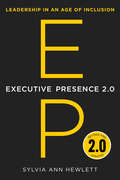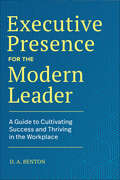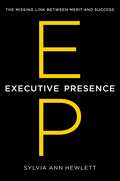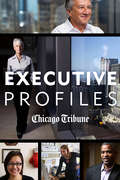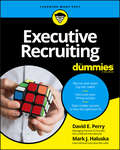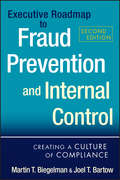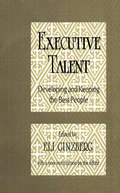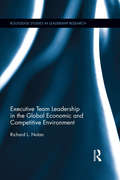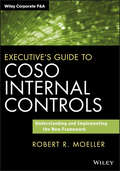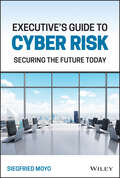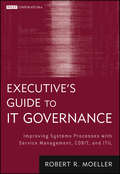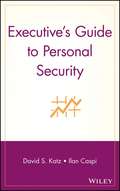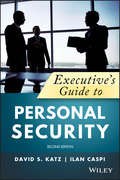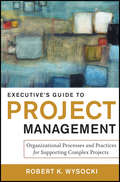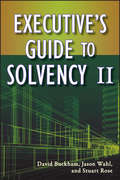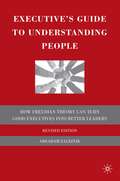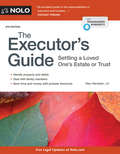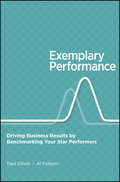- Table View
- List View
Executive Presence 2.0: Leadership in an Age of Inclusion
by Sylvia Ann HewlettIn this updated and expanded edition of her celebrated book Executive Presence: The Missing Link Between Merit and Success, one of the world’s most influential business thinkers reveals the qualities essential to leadership in our fast-changing, post-pandemic world. Some are timeless (confidence, decisiveness), some are brand new (the ability to command Zoom), and all are game-changers.Nearly a decade ago, economist Sylvia Ann Hewlett cracked the code of executive presence (EP). Drawing on complex data and in-depth interviews with senior executives from sectors as different as finance and fashion, she demonstrated that EP is a potent mix of gravitas, communication, and appearance.Executive Presence became a classic. Translated into seven languages, it’s helped tens of thousands of ambitious, accomplished professionals to fast-track their careers. Chuck Robbins (CEO of Cisco), and Thasunda Brown Duckett (CEO, TIAA), are among the leaders who recommend this book for any up-and-comer seeking to rise through the ranks and do something extraordinary with their lives.But EP has evolved. Black Lives Matter, the #MeToo movement, and a global pandemic have changed the leadership equation. But how? To answer that question, in 2022, Hewlett embarked on a second round of quantitative and qualitative research, targeting seasoned leaders and thirty-something-year-old executives at the cutting edge of the new economy (fin-tech, gaming, media). Her findings are timely as new executives find their feet in a post-pandemic world.Hewlett demonstrates that in 2023 leaders worldwide seek to promote high-performing men and women who exude confidence but also project authenticity and inclusivity. They’re also intent on advancing those who excel at leading remote teams and demonstrate a command of social media. It’s no coincidence that Eddie Glaude, Amanda Gorman, and Gustavo Dudamel are stars of this new edition of Executive Presence and the usual suspects.Hewlett’s most potent message, ten years ago and now, is that EP is eminently learnable. You don’t need to have the voice of James Earl Jones, the communication skills of Steve Jobs, or the athleticism of Michelle Obama to ace EP. You merely have to arm yourself with the tools and tactics contained in these pages.
Executive Presence for the Modern Leader: A Guide to Cultivating Success and Thriving in the Workplace
by D.A. BentonReach your professional goals with strategies for building executive presenceWhether you want to land a new job, succeed in your current role, secure a promotion, or change career paths, having up-to-date leadership skills is essential. Executive Presence for the Modern Leader is full of expert guidance and actionable steps for progressing in your career. You'll build the skills necessary to be more memorable, credible, and confident in the workplace.A breakdown of executive presence—Learn what executive presence entails, and explore the importance of emotional intelligence, communication, and authenticity.An exploration of leadership—Find straightforward explanations of different leadership styles, and take assessments to see which one you identify with so you can cultivate the leadership traits you want.Skill-building exercises—Strengthen your executive presence with thought-provoking writing prompts, business etiquette exercises, and more.A modern, inclusive approach—Read real stories about diverse leaders who embody executive presence at different stages of their careers.Take your leadership skills to the next level and thrive at work.
Executive Presence: The Missing Link Between Merit and Success
by Sylvia Ann HewlettDo you exude confidence and credibility? Can you command a room? Sylvia Ann Hewlett, one of the world's most influential business thinkers, cracks the code of Executive Presence (EP) for men and women intent on winning the next plum assignment and doing something extraordinary with their lives.You might have the qualifications to be considered for your dream job, but you won't get far unless you can signal that you're "leadership material" and that you "have what it takes." Professionals are judged on presence as well as on performance. Using a wealth of hard data--including a new nationwide survey and dozens of focus groups--Hewlett reveals EP to be a dynamic mix of three things: how you act (gravitas), how you speak (communication), and how you look (appearance). She also draws on in-depth interviews with a wide selection of admired leaders to reveal how they embody and deploy key elements of EP. This book is immensely practical. Hewlett teases out tactics that can help you raise your game and close the gap between merit and success. She offers the unvarnished advice you won't get from supportive friends and tackles head-on such touchy subjects as too-tight clothing and too-shrill voices. She shows how the standards for EP vary for men, women, multicultural, and LGBT employees, and she shares how to get meaningful feedback from politically correct bosses intent on avoiding the real issues. The good news is that EP is eminently teachable. You can learn how to "show teeth" while remaining likable, and you can teach yourself how to dress appropriately while staying true to yourself. You don't have to be born with the voice of James Earl Jones or the looks of Angelina Jolie to hurdle the EP bar. With hard facts and vivid examples, Hewlett shows you how to ace EP and fully realize your unique potential--no matter who you are, no matter where you work.
Executive Profiles
by Chicago Tribune StaffCollected from the Chicago Tribune's column of the same name, Executive Profiles is an intimate and informative look into the lives of top Chicago business and organization leaders, executives, and CEOs. These profiles do more than just detail the success of these individuals' companies, however. In discussions that range from family to hobbies to personal business philosophies, the interviewers seek to understand the people behind the heads of these stalwart Chicago institutions.Arranged by industry, Executive Profiles is a serious look at an eclectic range of Chicago's movers and shakers, but it also offers an entertaining peek into the more personal, human sides of these business leaders. For fascinating insight into the habits and philosophies of Chicago's driven business and nonprofit executives, look no further than this inspiring collection.
Executive Recruiting For Dummies
by David E. Perry Mark J. HaluskaTips and strategies to fill executive-level positions Recruiting for high-end executives requires a special skill-set, and Executive Recruiting For Dummies is here to help you add this niche talent to your arsenal. Whether you're an in-house human resources manager or a professional recruiter at a search firm, this friendly guide walks you through each step of filling that senior, executive, or other highly specialized position. This book covers the globalization of talent and the advantages of executive recruiting. It provides expert guidance on finding the right candidates, conducting hardy screening and interviewing processes, closing deals, and more. There are 10,000,000 businesses in America that hire at least one senior executive a year, and most turn to commissioning a third-party organization, such as an executive search firm. Rather than losing that next top-tier recruiting job, let Executive Recruiting For Dummies show you how to add this highly desirable and sought-after skill to your resume. Learn to recruit with precision Create a robust interview process Close the deal with a winning offer Find out how to work with professional recruiters Discover how to find the best talent and retain and attract clients with the help of Executive Recruiting For Dummies.
Executive Remuneration at Reckitt Benckiser plc.
by Jay W. Lorsch Krishna G. Palepu V. G. Narayanan Lisa Brem Ashley C. RobertsonReckitt Benckiser plc has developed an executive compensation system. This case outlines the structure of the system, its emphasis on performance-based pay and a global outlook, and explains the role of the human resources department, the board of directors, and company shareholders in determining pay. It raises questions about how to balance incentive remuneration effectively in recruiting and retaining top managers, while addressing shareholder concerns about executive compensation.
Executive Roadmap to Fraud Prevention and Internal Control
by Martin T. Biegelman Joel T. BartowNow in a Second Edition, this practical book helps corporate executives and managers how to set up a comprehensive and effective fraud prevention program in any organization. Completely revised with new cases and examples, the book also discusses new global issues around the Foreign Corrupt Practices Act (FCPA). Additionally, it covers best practices for establishing a unit to protect the financial integrity of a business, among other subjects. The book has many checklists and real-world examples to aid in implementation and an instructor's URL including a test bank to aid in course adoptions.
Executive Shirt Co., Inc.
by Janice H. Hammond Sylvie RyckebuschThe Executive Shirt Co. is contemplating a move into custom-made shirts. The company's general manager has charged two of his managers to come up with plans for incorporating production of custom shirts into the existing manufacturing process.
Executive Talent: Developing and Keeping the Best People
by Peter BlauThis brilliant, up-to-date compendium argues that the most successful factor in company life is good people: individuals who are capable, competent, and savvy. Can corporate life attract such people? Ginzberg argues that despite demographic dislocations and the challenges to the work ethic, the answer to this question is a loud yes. In Executive Talent, Ginzberg and his colleagues show how to attract, train, and promote a superior work force, and how to take advantage of the different values in today's employees.Over 25 percent of the population currently graduates from a senior college, and the number going for advanced degrees is climbing. Blacks and Hispanics together will soon account for one in every four new native-born job applicants. Women are now nearly as prevalent in the work force as men. Today's employees place more emphasis on family and leisure, and less on company loyalty. In the face of these critical changes, companies can no longer continue with the same human resource policies. Ginzberg offers new approaches to attract and retain superior talent.In Executive Talent, Ginzberg brings together top academics and high level executives to explore the new world of work. They discuss coming trends and changes that will reshape the talent pool, how these shifts will impact the individual company, and ways to develop and implement a human resource strategy to meet the challenging work force of the future.
Executive Team Leadership in the Global Economic and Competitive Environment (Routledge Studies in Leadership Research)
by Richard L. NolanCorporations have continued to grow and extend their operations into the global economy to the point that the modern corporation has become larger and more influential than many sovereign countries. In this global expansion, corporations have extended their operations with little restraint—almost only limited by corporate lawyers’ imaginations. Modern corporations have become so pervasive; world populations are more dependent on them for their food, services, technologies, work and daily well-being than ever before. This book analyzes the twenty-first century forces challenging the executive leadership of the modern corporation. Lessons are drawn for corporate leaders facing these challenges: turbulent times, balancing creators and stewards, managing company culture, managing by wire, incorporating global virtual organization structures, and managing sustained innovation. Nolan concludes with guidelines on creating a leadership agenda for transforming the corporation to successfully compete in the realities of the new corporate world of the twenty-first century.
Executive as Coach
by James Waldroop Timothy ButlerHow do you deal with the talented manager whose perfectionism paralyzes his direct reports? Or the high-performing expert who disdains teamwork under any circumstances? What about the sensitive manager who avoids confrontation of any kind? Do you ignore the behaviors? Get rid of the managers? James Waldroop and Timothy Butler suggest that you coach them. They have found that coaching--helping change the behaviors that threaten to derail a valued manager--is often the best way to help that manager succeed. Executives increasingly recognize that it is people management skills that are the key both to their personal success and to the success of their business. And being an effective coach is a crucial part of successful people management.
Executive's Guide to COSO Internal Controls
by Robert R. MoellerEssential guidance on the revised COSO internal controls frameworkNeed the latest on the new, revised COSO internal controls framework? Executive's Guide to COSO Internal Controls provides a step-by-step plan for installing and implementing effective internal controls with an emphasis on building improved IT as well as other internal controls and integrating better risk management processes. The COSO internal controls framework forms the basis for establishing Sarbanes-Oxley compliance and internal controls specialist Robert Moeller looks at topics including the importance of effective systems on internal controls in today's enterprises, the new COSO framework for effective enterprise internal controls, and what has changed since the 1990s internal controls framework.Written by Robert Moeller, an authority in internal controls and IT governancePractical, no-nonsense coverage of all three dimensions of the new COSO frameworkHelps you change systems and processes when implementing the new COSO internal controls frameworkIncludes information on how ISO internal control and risk management standards as well as COBIT can be used with COSO internal controlsOther titles by Robert Moeller: IT Audit, Control, and Security, Executives Guide to IT GovernanceUnder the Sarbanes-Oxley Act, every corporation has to assert that their internal controls are adequate and public accounting firms certifying those internal controls are attesting to the adequacy of those same internal controls, based on the COSO internal controls framework. Executive's Guide to COSO Internal Controls thoroughly considers improved risk management processes as part of the new COSO framework; the importance of IT systems and processes; and risk management techniques.
Executive's Guide to Cyber Risk: Securing the Future Today
by Siegfried MoyoA solid, non-technical foundation to help executives and board members understand cyber risk In the Executive's Guide to Cyber Risk: Securing the Future Today, distinguished information security and data privacy expert Siegfried Moyo delivers an incisive and foundational guidance for executives tasked with making sound decisions regarding cyber risk management. The book offers non-technical, business-side executives with the key information they need to understand the nature of cyber risk and its impact on organizations and their growth. In the book, readers will find: Strategies for leading with foresight (as opposed to hindsight) while maintaining the company&’s vision and objectives Focused, jargon-free explanations of cyber risk that liken it to any other business risk Comprehensive discussions of the fundamentals of cyber risk that enable executive leadership to make well-informed choices Perfect for chief executives in any functional area, the Executive&’s Guide to Cyber Risk also belongs in the libraries of board members, directors, managers, and other business leaders seeking to mitigate the risks posed by malicious actors or from the failure of its information systems.
Executive's Guide to IT Governance: Improving Systems Processes with Service Management, COBIT, and ITIL (Wiley Corporate F&A #637)
by Robert R. MoellerCreate strong IT governance processes In the current business climate where a tremendous amount of importance is being given to governance, risk, and compliance (GRC), the concept of IT governance is becoming an increasingly strong component. Executive's Guide to IT Governance explains IT governance, why it is important to general, financial, and IT managers, along with tips for creating a strong governance, risk, and compliance IT systems process. Written by Robert Moeller, an authority in auditing and IT governance Practical, no-nonsense framework for identifying, planning, delivering, and supporting IT services to your business Helps you identify current strengths and weaknesses of your enterprise IT governance processes Explores how to introduce effective IT governance principles with other enterprise GRC initiatives Other titles by Robert Moeller: IT Audit, Control, and Security and Brink's Modern Internal Auditing: A Common Body of Knowledge There is strong pressure on corporations to have a good understanding of their IT systems and the controls that need to be in place to avoid such things as fraud and security violations. Executive's Guide to IT Governance gives you the tools you need to improve systems processes through IT service management, COBIT, and ITIL.
Executive's Guide to Personal Security
by David S. Katz Ilan CaspiAs a company or an individual, you cannot control the desire and the ability of criminals and terrorists. However, you have full control over effectively lowering your risk of being attacked by increasing security measures?physical, technical, and procedural. The less vulnerable we are, the less attractive we are to any criminal or terrorist planning an attack. Let Executive?s Guide to Personal Security show you how to ensure safety both at home and abroad. Order your copy today!
Executive's Guide to Personal Security
by David S. Katz Ilan CaspiThe proven safety tips and techniques for corporate executives, revised and updated The revised and updated second edition of Executive's Guide to Personal Security, 2nd Edition offers a strategic handbook for ensuring safety for executives, their employees, and their corporate assets. The book’s lessons outline the basic rules of personal security; it shows how to recognize and prepare for the real threats faced by executives and ordinary individuals in today’s often hostile world. It is filled with the necessary knowledge that can empower executives to face these threats and deal with them successfully. The methods outlined herein, formerly reserved for security professionals and government employees, are made available to the reader. Executive's Guide to Personal Security will teach you situational awareness which allows you to identify potential dangers before they become serious threats. You will learn how to analyze risks, prepare for emergencies, travel safely, and utilize counter-surveillance techniques to enable you to recognize if you are being followed or targeted. You will gain an understanding of the threats to both personal safety and corporate assets and understand how to implement the appropriate counter-measures to deal with those perceived threats. With Executive’s Guide to Personal Security, you can learn to take necessary actions to reduce your chances of becoming a target and discover how to make yourself less vulnerable. Written by two seasoned security experts, the lessons presented can be used by those in the business world as well as anyone who would like to feel more secure, including those traveling to foreign countries and individuals studying abroad. New to the second edition is: Information for responding to an active shooter incident Enhanced details for protecting IP and computers and smart phones Strategies for planning for emergencies at home and the office Approaches to safety that meet the challenges of today’s world Executive's Guide to Personal Security, 2nd Edition is the comprehensive book that contains information on physical security, principles of route selection, technical security systems, hostage situations, emergency planning, hotel and room selection, armored products, communications, bomb threats, evacuations, and local criminal hazards.
Executive's Guide to Project Management
by Robert K. WysockiHow-to guidance for defining and implementing a complex project performance environmentSharing his forty-five years of project management experience, best-selling author and industry guru Robert Wysocki presents a straightforward, enlightening, and pragmatic guide to help senior managers make the transition to an organization that profits and thrives on complexity. The first book to discuss practical project management mitigation strategies, Executive's Guide to Project Management presents easy-to-implement infrastructures and processes that will ensure the continued success of your organization and maximize your investment of every project.Collects in one resource all the relevant information for understanding and creating an environment for improved complex project performanceA must-read for every member of your senior management teamShows you how to regain responsibility, take action, and skillfully handle complexity to mitigate risk and increase return on project investmentsIt's time for your senior management team to take back control of your investments in projects and programs. Executive's Guide to Project Management shows you how to cultivate your part of the organization so that it can respond to a changing project environment with the infrastructure to support the project and program investment decisions.
Executive's Guide to Solvency II
by Stuart Rose David Buckham Jason WahlA straightforward guide to the evolution, benefits, and implementation of Solvency IIProviding a guide to the evolution, practice, benefits, and implementation of Solvency II, Executive's Guide to Solvency II deftly covers this major European regulation which ensures that insurers can meet their risk-based liabilities over a one-year period to a 99.5% certainty. Part of the Wiley and SAS Business series, this book will guide you through Solvency II, especially if you need to understand the subtleties of Solvency II and risk-based capital in basic business language. Among the topics covered in this essential book are:Background to Solvency IILearning from the Basel ApproachThe Economic Balance SheetInternal ModelsPeople, Process, and TechnologyBusiness Benefits of Solvency IIExecutive's Guide to Solvency II has as its aim an explanation for executives, practitioners, consultants, and others interested in the Solvency II process and the implications thereof, to understand how and why the directive originated, what its goals are, and what some of the complexities are. There is an emphasis on what in practice should be leveraged upon to achieve implementation, specifically data, processes, and systems, as well as recognition of the close alignment demanded between actuaries, the risk department, IT, and the business itself.
Executive-in-Chief: The Importance of Framing and Repetition
by Jeffrey PfefferIn this chapter, the author presents four important and generally applicable lessons on leadership gleaned from George W. Bush's political career.
Executive’s Guide to Understanding People
by Abraham ZaleznikZaleznik takes managers into Freud's world of psychoanalysis and shows managers what they need to know about themselves and their employees to better motivate and lead. He discusses a variety of things relevant to today's top leaders including Freud's origin of psychoanalysis, the unconscious, neuroses, organizations and change.
Executor's Guide, The: Settling a Loved One's Estate or Trust
by Mary RandolphThe Executor's Guide shows someone who's wrapping up a loved one's estate how to proceed, step by step. It explains what must be done right away and what can wait, and guides readers through a land of unfamiliar legal procedures and terminology. It covers: preparing for the job of executor or trustee the first steps to take claiming life insurance, Social Security, and other benefits making sense of a will what to do if there is no will how to determine whether probate is necessary--it may not be! managing assets a child inherits taxes an overview of probate court proceedings what you can do to avoid disputes with family members handling trusts looking up your state's laws, and working with lawyers, appraisers, accountants and other experts. The Executor's Guide contains tables that outline key points of each state's laws, the latest information on estate tax laws, and helpful worksheets.
Exel plc--Supply Chain Management at Haus Mart
by Steven C. Wheelwright Zeynep TonExel plc is a global third-party logistics provider, serving clients such as Home Depot, Dell, Unilever, and Marks & Spencer. Describes the range of activities Exel performs for its clients and the capabilities the company has developed. Exel traditionally focused on freight management and contract logistics services and is now considering providing supply chain planning services. Management believes that there is tremendous potential in combining supply chain planning with supply chain execution. However, there are risks involved in entering the new business. Describes the decision in the context of Exel's two-decade relationship with Haus Mart, a leading retailer of home textiles, housewares, and home accessories in Germany.
Exemplary Performance
by Paul H. Elliott Alfred C. FolsomWhen a company brings back the 'lessons learned' from a benchmarking experience, it is often difficult or impossible for the company to take what it has learned and implement these insights within its own culture. This book offers a more productive alternative to these benchmarking exercises. HR, OD, business leaders and their organizations will discover a proven methodology for building an ever-expanding pool of higher performing individuals and teams. The book clearly demonstrates how star performers are identified, what organizations need to do to capture the high performance attributes of these employees, and finally how to disseminate this valuable information so that other individual performers and teams can use it to boost their own performance.
Exercise on Estimation
by John T. Gourville Jason RiisThis exercise is meant to assess students' level of confidence around everyday business and general knowledge questions, for the purpose of identifying where they are overconfident and underconfident.
Exercises in Negotiation Analysis
by George WuTwo exercises designed to illustrate the relationship between BATNAs (best alternative to a negotiated agreement) and reservation prices and three exercises that illustrate the central ideas of Pareto efficiency are presented. The BATNA exercises involve multiple negotiated alternatives and uncertainty. The Pareto efficiency exercises illustrate the value of side payments and differential valuation of issues in the creation of joint gains.
